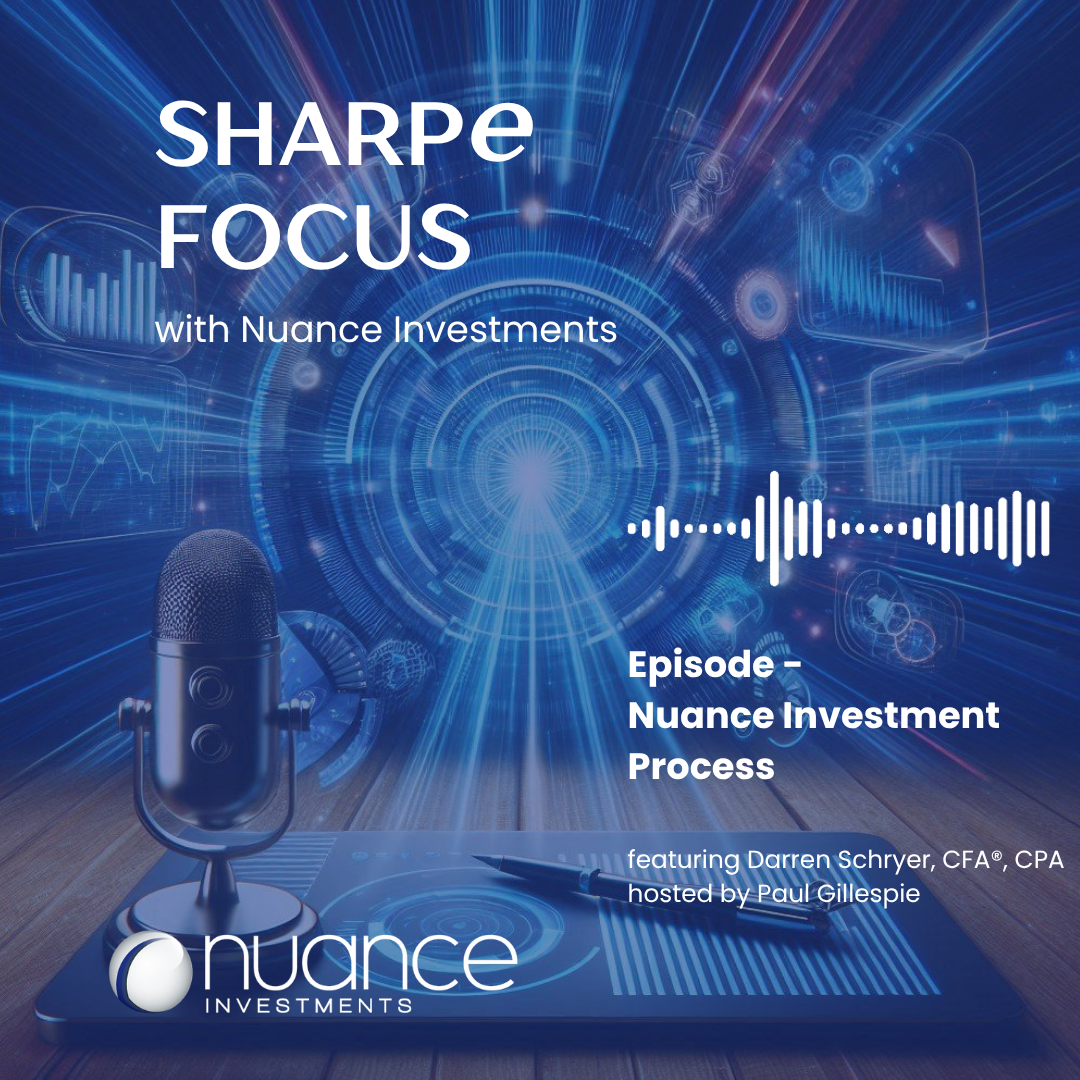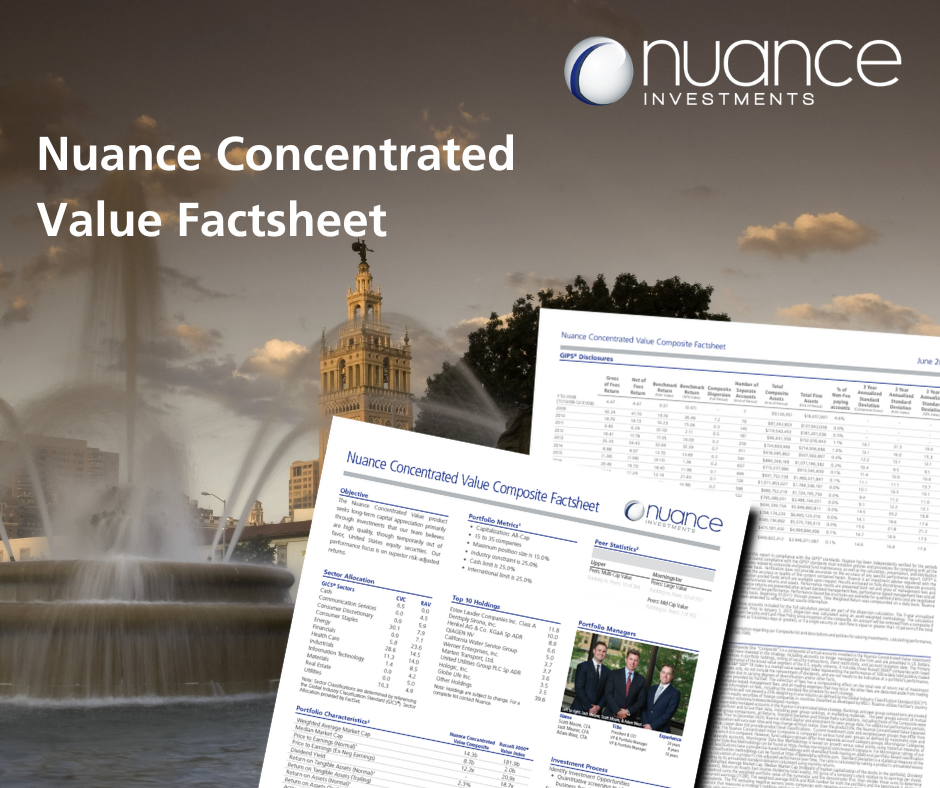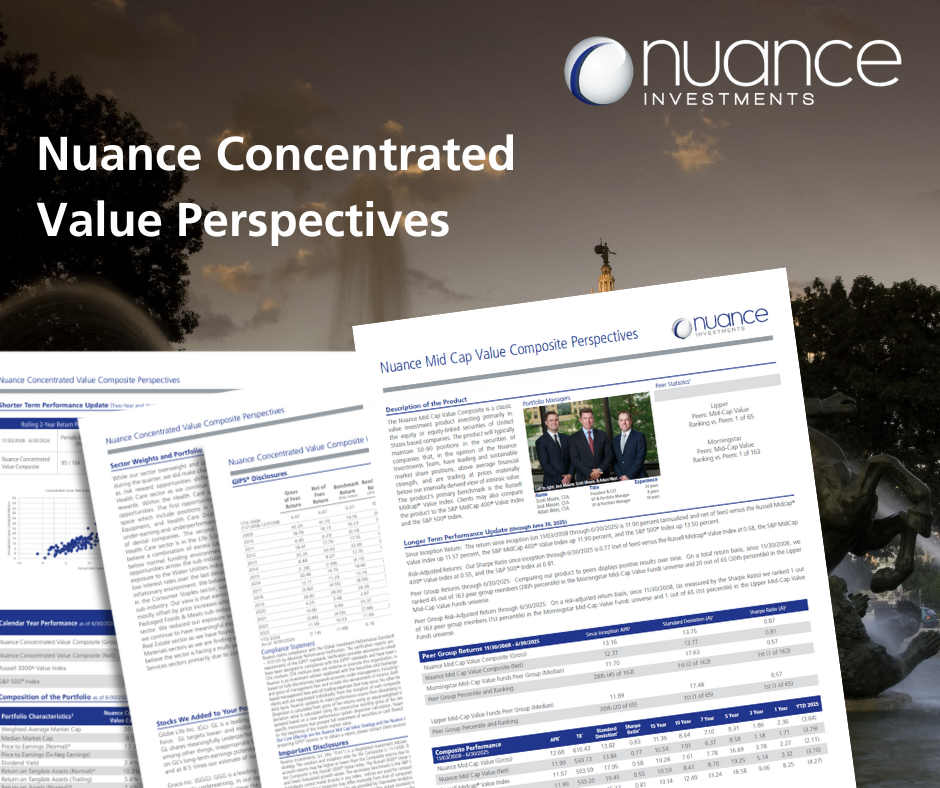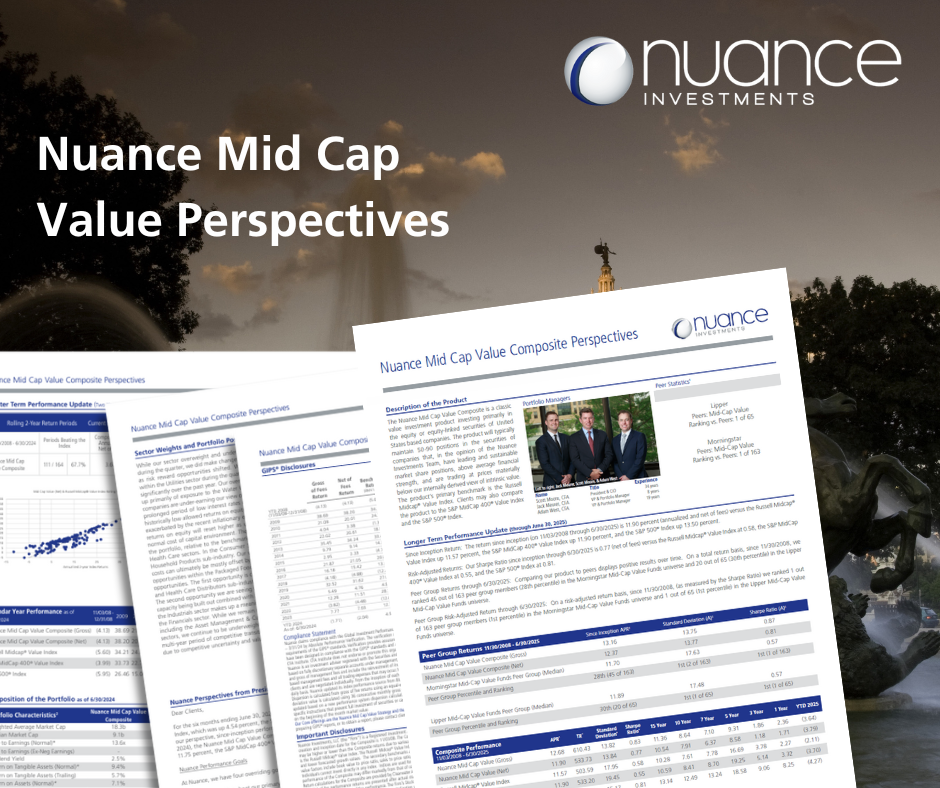
Episode - Nuance Investment Process
Sharpe Focus is a new podcast series featuring discussions with the Nuance Investment Team. We will be covering topics that we believe our partners will find insightful. Nuance is a boutique value manager that is 100% employee-owned.
The team focuses on buying leading business franchises with sustainable competitive positions that are trading at a discount to our internally derived fair value. We aim to outperform our primary and secondary benchmarks on an absolute and risk-adjusted basis, as measured by Sharpe ratio, over the long term.
In this episode, Paul Gillespie and Darren Schryer, CFA®, CPA discuss our Nuance Investment Process.
The views expressed are those of Nuance Investments as of the date of this podcast and are subject to change at any time. These views are for informational purposes only and should not be relied upon as a recommendation to purchase any security or as investment advice. To view the most current and standardized performance figures available click here for Nuance Mid Cap Value and here for Nuance Concentrated Value. To view the most current top holdings click here for Nuance Mid Cap Value and here or Nuance Concentrated Value.
Investing involves risk, including the possible loss of principal. For more information or a copy of our disclosure brochure, please contact client.services@nuanceinvestments.com. Past performance is not a guarantee of future results.
[00:00] Paul Gillespie
Hi everybody, it’s Paul Gillespie from Nuance Investments and I want to welcome you to our podcast Sharpe Focus with Nuance Investments. We spent our first three episodes talking about different opportunities we’re finding within today’s market, but today we thought it might be helpful for our listeners to hear more about the investment process that drives those decisions to invest in those specific opportunities. I’m joined today by our Portfolio Manager, Darren Schryer.
Darren’s been with the firm for almost 10 years, first as an Investment Analyst and now as a Portfolio Manager.
[00:40] Darren Schryer
Hey Paul, looking forward to discussing what makes our process unique.
[00:44] Paul Gillespie
Great Darren, and before we jump into the investment process, maybe give a little bit of history on this process we’ve been executing since the inception of the firm in late 2008.
[00:57] Darren Schryer
Yeah, this is a process that’s lived through multiple economic cycles. Members of our team have been executing it for more than 25 years and we’ve been executing it here at Nuance for around 16 years. We kind of view ourselves as stewards of the process.
We’re constantly trying to hone it, to optimize it, to enhance it, but the core of the process, the core of what we’re trying to do, has not changed over time and we do not anticipate it changing over time. We think consistent execution of the process gives us the best opportunity to outperform and the best opportunity to deliver consistent results in line with with our goals. In short, we’re trying to identify what we call leading business franchises, then buy them when they are under-earning and trading at a discount to our view of fair value for some sort of a transitory reason.
[01:56] Paul Gillespie
What is the final goal of this process?
[02:01] Darren Schryer
Primarily, we’re trying to deliver risk-adjusted return outperformance versus our peers and versus our benchmarks over a full market cycle, over the long term.
[02:13] Paul Gillespie
With that, let’s jump into the first step of the process, which is quantitative screening.
[02:21] Darren Schryer
Yeah, so, within quantitative screening, most investment processes start with a screening step.
We think ours is pretty unique. What we’re trying to do is identify potential leading business franchises. We’re not just trying to identify cheap stocks like many are.
What we’re doing is we’re breaking the investable universe down into 163 sub-industries and then within each sub-industry, we’re looking for businesses that have higher returns on capital than their sub-industry peers and also less volatility of those returns on capital. We’ve observed in our studies of history of all these different sub-industries that those characteristics are most commonly associated with leading businesses. We’re also screening for balance sheet strength over time and we’re screening for rational capital spending habits over time.
[03:19] Paul Gillespie
Once we’ve done this quantitative screening and we’ve identified companies that look like they could be leaders, what’s the next step?
[03:29] Darren Schryer
When it comes to new idea generation, when we think we have a company that might fit what we’re looking for, we move on to competitive analysis. Basically, what we’re doing here is we’re breaking a business apart into what we think are its rational, analyzable business segments and then for each one, we are studying the competitive position. Think Porter’s Five Forces type characteristics and really what we’re looking for are companies that are number one, number two type market share players within their niche.
We’re looking for companies with stable or gaining market share. We’re trying to avoid market share losing businesses. We’re also trying to avoid competitive transitions.
These are generally major new technologies that could introduce significant uncertainty into the future of the business. We know that we don’t know what the future is going to hold. We don’t have a crystal ball, but the higher conviction we have in the competitive position of a business being maintained or even improving over the next 5, 10, 15 years, that competitive position being sustainable, that’s what we’re after.
Lots of investors say they want to invest in leaders. We do think we go deeper in this step than most and we’re trying very hard to be ahead of the curve on those competitive transitions. Good work on competitive positioning is one of the absolute best things you can do as a value investor to avoid value traps.
Value traps are very common among businesses with poor competitive positions, but what look like cheap stocks.
[05:16] Paul Gillespie
Once we’ve done the competitive work and we’ve identified that a company looks like it has the competitive position and sustainability that we value long-term, what are we trying to do next?
[05:30] Darren Schryer
Yeah, so at this point in the process, we haven’t really done any detailed financial statement work and if a company does not fit what we’re looking for in terms of competitive position, we cut the review off right there.
We don’t want to waste our time pursuing an inferior business or a poor competitively positioned business. For companies that do fit what we’re looking for in competitive position, we’re studying historical returns on capital for the business. These are mature businesses we’re investing in.
Every one of these businesses has some degree of cyclicality to the business. Some have more, some have less, but our financial statement analysis is designed to take advantage of that inherent cyclicality. We’re studying historical peak returns on capital, historical trough returns on capital, and everything in between.
We’re also studying peer returns on capital. What we’re trying to do is normalize the financial statements to a stable, rational, middle-of-the-cycle state of returns. We’re not trying to project next quarter.
We’re not trying to project next year. We’re trying to normalize the financial statements. And then we’re trying to buy companies when they are under-earning for a transitory reason.
This normalization process is pretty unique, and it’s a pretty differentiated part of what we do. Most investors are projecting, they’re using street numbers, and ultimately what they’re doing is chasing numbers higher or lower based on short-term results of the business. That’s not what we’re doing.
We are trying to normalize the financial statements. Beyond the return on capital profile of the business, we’re also studying balance sheets very closely. We want stronger than industry average balance sheets.
We want balance sheets that can withstand a trough earnings environment without the company needing to take dilutive action like issuing equity or cutting expenses to the bone and starving the business of investments. We’re also talking to the management teams of all the businesses we invest in. We want to know how they are allocating capital.
We want to make sure that it’s rational how they are choosing to invest internally or externally within the business.
[07:50] Paul Gillespie
So we have now completed three steps of the process. We’ve identified these companies we think have leading business franchises, and we understand them now in their most normal operating environment.
What are we doing to follow up on valuation?
[08:09] Darren Schryer
Within valuation, we’re not using projections. We’re not using trailing 12-month earnings. We’re using our normalized set of financial statements over history.
We are studying how the stock traded on a couple different metrics, price to earnings, dividend yield using a normalized payout ratio, EBITDAR. We also have a proprietary unlevered free cash flow yield calculation that puts all businesses on an even balance sheet footing. We’re studying the history of the stock and how it’s traded.
We’re also studying comparable companies. We’re studying takeover multiples, private market multiples, and we’re trying to identify a fair value for the business. Very importantly, beyond that, we’re also studying how the stocks traded in their worst periods.
This could be for an idiosyncratic reason, for a one-off reason, or it could be for a larger reason like the global financial crisis. Many companies traded down to their trough earnings environment. We want to know in a worst case scenario, how cheap can these stocks get? And that focus on downside risk is unique to us.
Those two values, our fair value price target and our risk to the downside or trough value price target, make up what we think of as a risk-reward ratio.
[09:40] Paul Gillespie
We’ve got a list of wonderful businesses now, but they’re probably not all great values at the same time or risk-rewards at the same time. How do we decipher that?
[09:54] Darren Schryer
Our list of approved businesses that fit all of the characteristics we’re looking for across competitive position, return on capital certainty, balance sheet strength, capital allocation, that list has around 200 members today.
Historically, it’s ranged between 200 and 250. We think those are the best businesses in the world. As you can see, with only 200 to 250 names in a universe of thousands of potentially investable stocks, it’s a pretty tight filter on the type of business we’re willing to invest in.
And what we’re doing is we’re trying to build a portfolio that maximizes return to fair value and minimizes risk to trough value. And typically, the way this happens is that when a company is under-earning for a transitory reason, they’re missing their numbers, they’re cutting expectations, the stock is reacting negatively, the street is bearish. And this is when the stock is its cheapest, is when it’s also under-earning.
As a contrarian by nature, this is the absolute ideal time to be buying the stock. It’s actually the least risky point to be investing new capital. From there, the point of under-earning, financial performance of the business is most likely to improve, to progress towards normalized earnings power.
And valuation has the least additional risk of additional multiple compression and the most potential upside to multiples. And that’s the type of portfolio we’re trying to build, of companies that are under-earning and undervalued.
[11:34] Paul Gillespie
That’s a great summary of the investment process, and I appreciate you taking the time to go through that with us today.
I do think one thing we could have some fun with in the near future is do an episode where we talk about each step of the process and some different examples that we’ve seen over time. So let’s count on that, Darren.
[11:55] Darren Schryer
That’s a great idea, Paul.
[11:57] Paul Gillespie
Well, thank you all for joining us for our podcast. We’d love to hear from any of our listeners with any feedback or follow-up they might have. And we’ll see you soon for our next Sharpe Focus with Nuance Investments episode.
Michael Porter’s five-force is a strategic analysis model, introduced in a 1979 article published in the Harvard Business Review, which remains a fundamental tool for strategic analysts plotting the competitive landscape of an industry.
Nuance Trough Earnings is an internal estimate of earnings that is representative of the lower bound of earnings a company can reasonably be expected to generate and is reflective of our historical analysis of returns on capital and adjustments to reported income.
The Price to Earnings ratio measures the price of a company’s stock in relation to its earnings per share.
Dividend yield is measured as a security’s indicated annual dividend divided by the share price of the security.
EBITDAR (Earnings Before Interest, Tax, Depreciation and Amortization) is a metric used in assessing the operating earnings of a company.
Return On Capital is a calculation that indicates how well a firm can convert capital into earnings.
Nuance Normalized Earnings is an internally derived calculation of earnings based on historical analysis and adjustments to reported income.
Unlevered Free Cash Flow is an internal calculation estimating free cash flow per share if the company has a completely debt neutral capital structure and dividing it by share price to derive the unlevered free cash flow yield.
The information presented related to the Nuance investment decision and selection process is intended to be informational in nature, speak to our process and does not represent a recommendation in any specific security or securities. Information not specific to a cited source constitutes the opinion of the Nuance Investment Team and should not be relied upon to make investment decisions. Investors should be aware of the risks associated with data sources including without limitation, fundamental, technical, qualitative, and quantitative factors used in our investment process. Errors may exist in data acquired from third party vendors, the development of investment ideas, the analysis of data, and the portfolio construction process. While Nuance takes steps to verify information to minimize the impact of potential errors, we cannot guarantee that errors will not occur.
How to invest
Nuance has been managing portfolios for individuals and institutions using the same classic value investment philosophy since first registering as an investment advisor in 2008. If you would like to receive material describing our services, including our historical performance records, please contact us.
Nuance Investments, LLC
4900 Main Street, Suite 220
Kansas City, MO 64112
Telephone: (816) 743-7080
Fax: (913) 387-2729
Nuance Investments, LLC • 4900 Main Street, Suite 220, Kansas City, MO 64112





